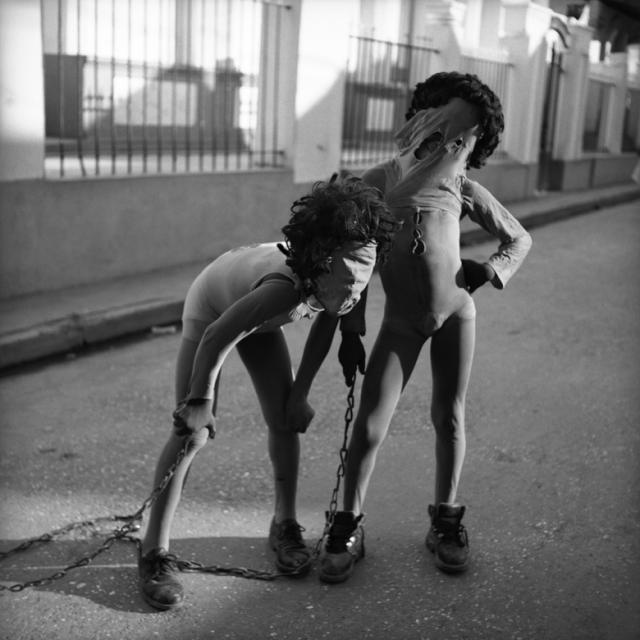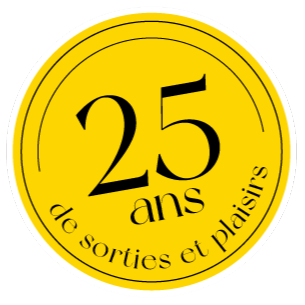British photographer Leah Gordon captures Haiti’s carnival spirit at PHI Centre
Auteur: Michael-Oliver HardingWe know, we know: any media coverage of Haiti rapidly devolves into a sobering reflection on “the poorest country in the Western hemisphere.” Why on Earth would anyone want to fly down there, if not to carry out noble humanitarian work as a doctor-without-border or to live in a plywood shack with Sean Penn & friends as you “rebuild the country”, right? Wrong. Turns out there’s way more than meets the (headline-chasing) eye. After celebrated author Dany Laferrière recently told NIGHTLIFE.CA that he’d like readers to “see that a country that evokes so much love in a writer must be a lovely country”, standout British photographer Leah Gordon travels to Montreal’s PHI Centre with a crate full of evidence that would back his claim.
A brazen young Gordon first visited Haiti in 1991 after hearing an on-air presenter warn listeners against traveling to this “land of Black magic, death and dictatorships.” But once there, she didn’t seek refuge at the nearest British embassy. She was rather quickly taken aback by the country’s rich cultural roots and traditions. Her photo exhibit Kanaval, on view at the PHI Centre from February 25 to April 27, chronicles the coastal town of Jacmel and its annual carnival. Gordon's powerful images show costume-clad participants of all stripes taking great pleasure in this pre-Mardi Gras ritual – one that's worlds away from those predictable boobs ‘n’ beads shots that have come to define the New Orleans Mardi Gras experience. NIGHTLIFE.CA spoke with the charming Gordon about unbounded Haitian creativity.
This Kanaval doesn’t seem to take its cues from any run-of-the-mill parade. It comes off as spontaneous, absurd street theatre. Why is that?
I think the Jacmel carnival is more rooted in the European Middle Ages, more deeply connected with the land and rural traditions. The whole thing is very unique – a very weird, lo-fi inversion of spectacle. There is no set time, route or parade. And this lack of traditional parade, I feel, is very important. This is what, in my mind, gives the space for the narrative, and consequently the history. To lose this fluidity with a procession would be to reduce the complex poetry of mask, gesture, theatre and costume to pure spectacle.
What can you tell us about the picture below?

It’s called ‘Esklav Yo’ (The Slaves) and was taken in 2001. I had never seen this costume before and have never seen it since. Some of the déguisements are one-off personal statements – there one day, gone the next. I took them to be references to slavery as they are anonymous, faceless and wearing chains and shackles.
Why did you opt for B&W photography with this series?
There’s a lot going on at the carnival – a huge amount of visual stimulation and colour saturation. Using colour would have severely restricted what I could photograph, as I would have been trying to balance the subject with the background, colour wise. So the use of B&W was a choice to damp down the stimulation and allow the costumes and the narrative to breathe.
You organized the first Haiti Ghetto Biennale in 2009, with artists from around the world flying in at their own expense. What was that experience like?
When I left London, I really believed that the concept of ‘political art’ was hollow lip service to perhaps an empty ideology, but at the first Ghetto Biennale, I witnessed that the creative act can intensely connect people from diverse genders, sexualities, classes, races and nationalities. We had the 2nd Ghetto Biennale in 2011 and the 3rd will take place at the end of this year. The experience of the first was incredible… It recalled the amazing and creative art happenings of the ‘60s and early ‘70s. Each visiting artist that arrived had to reconceive their project; throw it away and start again when faced with the circumstances of Haiti – but that was creative in itself.
In the media, Haitians are often portrayed as victims – of poverty, catastrophe or political turmoil. Yet, history seems to forget that Haitians organized the only successful slave revolt in history. Is that paradox part of what you find fascinating about the country?
Absolutely. Also, if you walk along any street there with a Haitian artist, you will quickly notice a phenomenon that would be rare in most other countries. People will greet him or her using ‘Atis’ as a professional title before their name. In Haiti, Artist is a term of respect equal to Doctor or Agronomist. These are titles that register professions that are both honourable and important for the life of the nation. Whilst the Agronomist tends to the land and the Doctor to the body, the Artist feeds the soul. ‘Pep La’ (the people) do not consider Haitian art as another cheap local export to a foreign land that holds no internal significance, but as something far more necessary and pregnant with possibilities.
Kanaval is on view from February 25 to April 27
PHI Centre | 407 St. Pierre | phi-centre.com
Kanpe Kanaval Afterparty as of 11pm on Saturday, February 23 at PHI Centre, with Gordon's exhibit and DJs Win Butler & Richard Reed Parry (Arcade Fire), Nom de Plume (Radio Radio), The Salivation Army, and DJ ACE.











